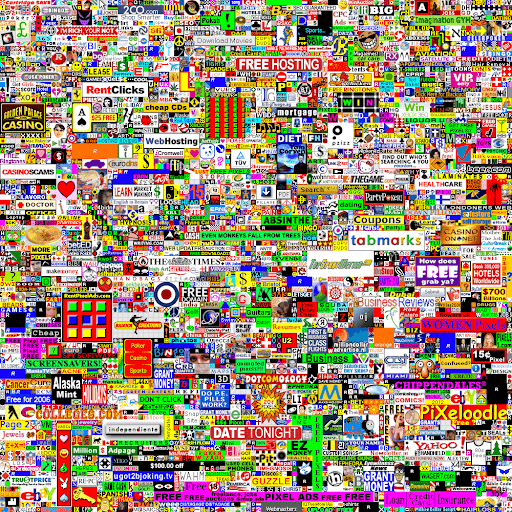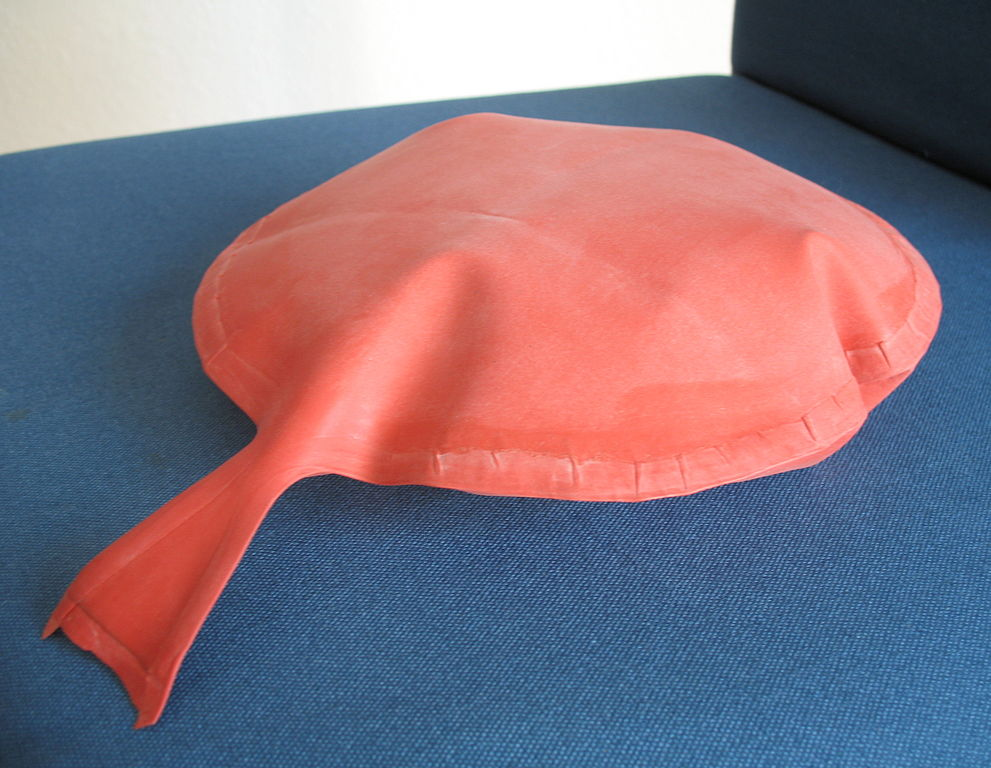In our articles, we talk a lot about generating valid startup ideas and how they would be solving real-world problems. But think for a moment about all the unnecessary stuff or apps you are surrounded by. People are creating this weird and crazy stuff, and they make millions off it, too.
1. Million dollar homepage
At the beginning of The 21st century, the internet was still a new thing. It’s no surprise that marketing didn’t work back then the way it does now. Alex Tew benefited from this fact and created the stupidest website the internet has seen to collect college money.

Alex bought a domain MillionDollarHomePage.com and started selling the space for marketing purposes. The logic was simple: He divided the main page by 1000 x 1000 pixels, then sold each for a dollar. Guess how much he made by the end of that year?
Succeeding with such an idea today sounds crazy. Marketers are trying their best to squeeze in ads in the content you might be interested in. Nobody will visit a page dedicated to ads, but someone had to do it somewhere sometime.
2. The cat that wanted a cheeseburger but conquered the internet instead
We see memes in almost every corner. One of the first players in the field started with a not-so-funny image of a cat, a not-so-funny text, and a not-so-memorable domain.

We all know that cats are too famous on the internet. How could we not, when we stumble upon them around every corner? That’s how one project’s road to success started. Eric Nakagawa and Cary Unebasami had so much fun when they saw the above cat’s image, they wrote a text on top of it and published it online under the same domain icanhas.cheezburger.com.
The fans of the cat appeared fast. They wanted to continue telling the story of the cat. Then others joined by all sorts of cat photos and videos. At its highest, the webpage attracted 400 million users in one month. In 2007, the company was sold for an impressive $2 million.
3. The fidget cube
You may think that making money with stupid ideas is a thing of the past, but let’s take a look at the current situation, and we’ll find even more impressive stuff. Remember the fidget cube? There was a lot of fuss going around about it. There still is.

Not a single button on this tiny cube serves any kind of purpose. Yet, it became one of Kickstarter’s most wanted products and got listed as the top ten most funded projects.
All its founders were asking was $15 000; they attracted around $6.5 Million instead.
4. The slime that became popular thanks to YouTubers
In the era of content creators, everything spreads faster and amongst many than before. The idea of one might make someone else richer too, and slime is a great example of that.
The product itself was created in the 70s, and it was sold just like any other toy. The hype around slime happened partly because of the YouTubers who were producing tons of entertaining content with slime. If you think there’s nothing special about that, ask those who made millions from such content.
As the queen of slime, Carina Garcia was a simple waitress before she stumbled upon YouTube’s gold mine. She started making slime videos in 2015, and by 2017 she was making around $200 000 a month. The interesting fact about her story is that the money came from investors and not from direct sales. Thanks to the silly videos with more than a couple hundred thousand views on average, Carina’s parents retired, and she even bought a house with a pool, a video studio, and a jacuzzi. The slime queen is still active on YouTube, and she even started her own small slime business.
5. iFart — The immortal joke that found its place in the digital world
You’ll most definitely remember this prank — a small sack that makes funny noises when someone sits on it. The toy was created back in the 30s and still remains popular, but who would have thought that we would witness its digital-analog too?

iFart came along during the mobile app craze. In 2008, an entrepreneur Joel Kohm decided to create a digital duplicate of the toy. The app costs around $1, and you can purchase different noises, too, such as “Burrito Maximo” or “Howard the Duck.” In the first days of its appearance, it made $10 000 a day. In total, the iFart app generated around $2 Million in revenue.
And what’s happening in Georgia?
Such wild ideas don’t need to be targeted on the global market. We come across such seemingly crazy but quite successful projects on local markets, too, like Georgia, for example. One good example is Altersocks. If you haven’t yet gotten their socks with famous Georgian Khinkali on them, you’ve definitely seen them on the streets — Everyone loves to show off the company’s genius design. Altersocks turned out to be a good option for a present, and they appear right in images too. Basically, people market the socks themselves.
The company hasn’t made millions off it, but it still turned out to be a successful company.

Not so stupid, huh? These projects are great indicators that the next big thing is hiding in very unusual places. Let’s remember the words of Paul Graham, the co-founder of Y combinator:
“Just as trying to think up startup ideas tends to produce bad ones, working on things that could be dismissed as "toys" often produces good ones.”



5 funny projects that ended up making millions
13 October 2020In our articles, we talk a lot about generating valid startup ideas and how they would be solving real-world problems. But think for a moment about all the unnecessary stuff or apps you are surrounded by. People are creating this weird and crazy stuff, and they make millions off it, too.
1. Million dollar homepage
At the beginning of The 21st century, the internet was still a new thing. It’s no surprise that marketing didn’t work back then the way it does now. Alex Tew benefited from this fact and created the stupidest website the internet has seen to collect college money.
Alex bought a domain MillionDollarHomePage.com and started selling the space for marketing purposes. The logic was simple: He divided the main page by 1000 x 1000 pixels, then sold each for a dollar. Guess how much he made by the end of that year?
Succeeding with such an idea today sounds crazy. Marketers are trying their best to squeeze in ads in the content you might be interested in. Nobody will visit a page dedicated to ads, but someone had to do it somewhere sometime.
2. The cat that wanted a cheeseburger but conquered the internet instead
We see memes in almost every corner. One of the first players in the field started with a not-so-funny image of a cat, a not-so-funny text, and a not-so-memorable domain.
We all know that cats are too famous on the internet. How could we not, when we stumble upon them around every corner? That’s how one project’s road to success started. Eric Nakagawa and Cary Unebasami had so much fun when they saw the above cat’s image, they wrote a text on top of it and published it online under the same domain icanhas.cheezburger.com.
The fans of the cat appeared fast. They wanted to continue telling the story of the cat. Then others joined by all sorts of cat photos and videos. At its highest, the webpage attracted 400 million users in one month. In 2007, the company was sold for an impressive $2 million.
3. The fidget cube
You may think that making money with stupid ideas is a thing of the past, but let’s take a look at the current situation, and we’ll find even more impressive stuff. Remember the fidget cube? There was a lot of fuss going around about it. There still is.
Not a single button on this tiny cube serves any kind of purpose. Yet, it became one of Kickstarter’s most wanted products and got listed as the top ten most funded projects.
All its founders were asking was $15 000; they attracted around $6.5 Million instead.
4. The slime that became popular thanks to YouTubers
In the era of content creators, everything spreads faster and amongst many than before. The idea of one might make someone else richer too, and slime is a great example of that.
The product itself was created in the 70s, and it was sold just like any other toy. The hype around slime happened partly because of the YouTubers who were producing tons of entertaining content with slime. If you think there’s nothing special about that, ask those who made millions from such content.
As the queen of slime, Carina Garcia was a simple waitress before she stumbled upon YouTube’s gold mine. She started making slime videos in 2015, and by 2017 she was making around $200 000 a month. The interesting fact about her story is that the money came from investors and not from direct sales. Thanks to the silly videos with more than a couple hundred thousand views on average, Carina’s parents retired, and she even bought a house with a pool, a video studio, and a jacuzzi. The slime queen is still active on YouTube, and she even started her own small slime business.
5. iFart — The immortal joke that found its place in the digital world
You’ll most definitely remember this prank — a small sack that makes funny noises when someone sits on it. The toy was created back in the 30s and still remains popular, but who would have thought that we would witness its digital-analog too?
iFart came along during the mobile app craze. In 2008, an entrepreneur Joel Kohm decided to create a digital duplicate of the toy. The app costs around $1, and you can purchase different noises, too, such as “Burrito Maximo” or “Howard the Duck.” In the first days of its appearance, it made $10 000 a day. In total, the iFart app generated around $2 Million in revenue.
And what’s happening in Georgia?
Such wild ideas don’t need to be targeted on the global market. We come across such seemingly crazy but quite successful projects on local markets, too, like Georgia, for example. One good example is Altersocks. If you haven’t yet gotten their socks with famous Georgian Khinkali on them, you’ve definitely seen them on the streets — Everyone loves to show off the company’s genius design. Altersocks turned out to be a good option for a present, and they appear right in images too. Basically, people market the socks themselves.
The company hasn’t made millions off it, but it still turned out to be a successful company.
Not so stupid, huh? These projects are great indicators that the next big thing is hiding in very unusual places. Let’s remember the words of Paul Graham, the co-founder of Y combinator:
“Just as trying to think up startup ideas tends to produce bad ones, working on things that could be dismissed as "toys" often produces good ones.”